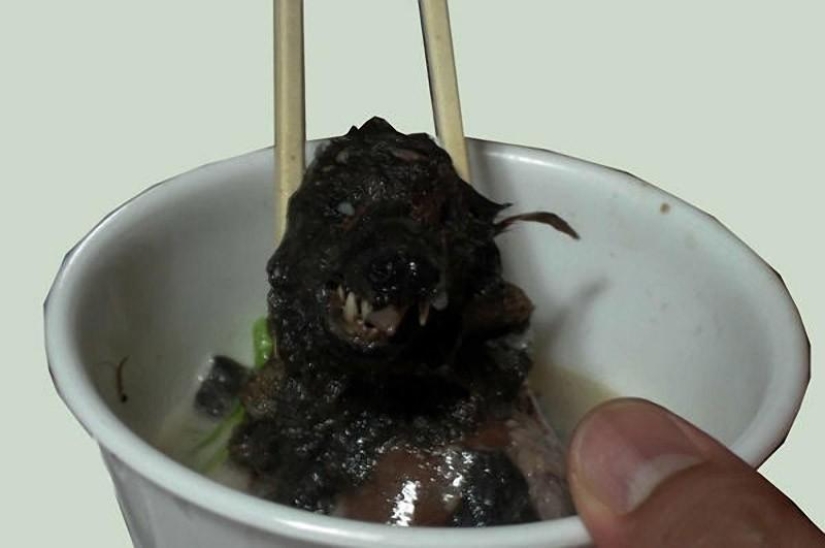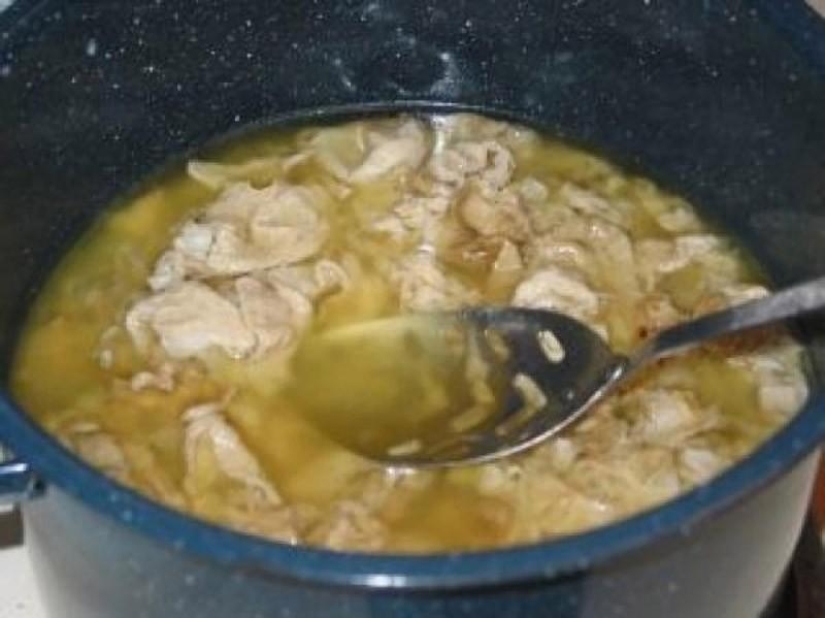10 dangerous foods
Categories: Food and Drinks
By Pictolic https://pictolic.com/article/10-dangerous-foods.htmlWhen we look at our food, we don't think too much about it, and in fact sometimes notice that it's ordinary. However, there are some foods that are so unusual and dangerous that they can kill anyone's appetite. In this selection you will see poisonous shark meat, neurotoxic fruits and bullfrog salad...

 1. Kharkal
1. Kharkal
Greenland sharks are not only dangerous for kayaking, but also for your stomach. The fact is that Greenland sharks do not have the ability to urinate, as a result of which a huge amount of ammonia and trimethyl oxide are excreted from the sharks’ body through the tissues. The enterprising Greenlanders have developed a traditional dish known as Harkal, which is aged shark meat. In addition to the almost unbearable smell of shark meat, the consumer faces the potential threat of organ damage, intoxication and illness from poisons that are still present in the meat.
 2. Kivak
2. Kivak
Kivak is an extremely difficult and dangerous food for the stomach. An ancient Icelandic food known as Kivak consists of the fermented (essentially decomposed) corpses of small seabirds such as guillemots and gulls. The birds are caught in nets and sewn into aged seal skins before being buried in the ground for up to three years. Birds are slowly marinated in seal oil in the cold Arctic tundra. As a result, the food, when finally dug up, not only looks somewhat disgusting, but can be deadly due to the possibility of botulism. The famous research biologist's last meal was Kivak.
 3. African poison bullfrogs
3. African poison bullfrogs
African poison bullfrogs are discussed in this article because they are marketed as a delicacy in the African country of Namibia. However, frog meat contains a powerful toxin known as Oshiketakata, which can lead to kidney failure, muscle damage and even death. Recommendations for treating frogs include placing them in a pot with special boards that supposedly “neutralize” the toxin. The level of poison is expected to be lower at certain times of the year when the food is made palatable to the brave, or perhaps the foolhardy in the case of wood planks. We cannot guarantee that the consumer will not croak...
 4. Braised Asian bats
4. Braised Asian bats
There are some foods that simply defy the imagination. Perhaps the most counter-intuitive food is Asian bat soup, which contains a whole bat in a bowl of soup after being simmered with chicken broth. The bat is cut with a knife and fork and the broth is then eaten with a spoon, along with the bat's innards. The dish contains hair and membranes from bat wings. The dish is quite tasty, but we have to conclude that it is very unappetizing, especially the bat type. Bats are capable of transmitting a number of human infectious diseases, in addition, this practice is considered incorrect from the point of view of many environmental organizations.
 5. Carambola
5. Carambola
Carambola is the most tempting and innocent looking food on this list. While other dishes can be complex or disturbing, carambola is simply beautiful. The Asian plant contains five facets that form a perfect star when the fruit is served sliced crosswise. After you eat this plant, stars may spin around your head as this fruit contains neurotoxins. Carambola also contains a huge amount of oxalic acid. This fruit affects those with weak kidneys, causing death in exceptional cases.
 6. Octopus tentacles
6. Octopus tentacles
A number of exotic Japanese and Korean restaurants, including those seeking to attract Western tourists, offer sushi that is not only raw but also partially live. Miniature octopuses are brought to sushi bars alive and quickly cut into two parts. When served on a plate with soy sauce, they still writhe due to a reflex in the tentacle, since the invertebrate animal has a partially decentralized nervous system. In several accidents, death occurred as a result of disembodied tentacles blocking the airways of visitors.
 7. Gastropod eggs
7. Gastropod eggs
Sturgeon eggs are known as caviar and are a popular dish in Russia, while snails are a popular French dish. Extreme entrepreneurs are popularizing a new delicacy known as “snail caviar,” which consists of raw land snail eggs. Eggs are served on hard-boiled quail eggs or along with fried vegetables and exotic salads. They come neatly packaged in little jars with a wonderful seasoning that carries the taste of fresh earth. Eggs are not cooked, so deaths have been reported from consuming raw snails infected with brain parasites.
 8. Snake burger
8. Snake burger
In the southwestern United States, rattlesnakes are not only feared, but also eaten. Proponents of “snake food” note that snake meat is very similar to chicken, due to the fact that reptiles are the ancestors of birds. This amazing southern dish is very...authentic... In Southeast Asia, cafes are actively marketing their own snake snacks in the form of snake burgers made from cobras and other snakes. Snake meat is completely safe to eat, since the toxin is not distributed into tissues. Once skinned and fried, you'll never know you're not eating beef or chicken.
 9. Entrails
9. Entrails
The insides of the digestive, reproductive and nervous systems of some animals form the basis of some grotesque but surprisingly popular dishes. Many dishes use the stomach linings, intestines and even testicles of cows and sheep. "Giblets" must be carefully cleaned, as questionable body parts are often used, but can be surprisingly neatly served in diners. Lamb testicles are one of the most popular, and are served breaded, while ox testicles are marinated in a sauce. In Europe, a dish known as tripe may be served, which is made from pig intestine. Sheep heads and fish eyes also appear on the menu. The risks of fatal infections from parasites have led to a number of regulations on the consumption of sheep entrails and heads.
 10. Crow Pie
10. Crow Pie
Telling someone to “eat crow” is not a joke and is not even offensive if you are in Lithuania. Crow pie is a traditional poultry dish based on the meat of carrion crows. The birds are caught at a fairly young age, cooked over high heat in oil, and then served with a plate of roasted vegetables. The meat is rumored to act as an aphrodisiac, and is allegedly used to "control" the number of crows. Crows are a traditional part of Lithuanian food, but consumption declined sharply during the Soviet occupation of the country. Concerns have been raised about the possibility of contracting diseases from scavengers.
Recent articles

Twitter user @FactBuffet collects interesting facts about everything. Today we bring to your attention another series of facts that ...

Aomori Prefecture in the north of the Japanese island of Honshu is an agricultural region famous for its delicious apples. In ...

Imagine a baby vampire or a tiny zombie with glass eyes ... An artist from the USA Bean Shanine specializes in creating such ...